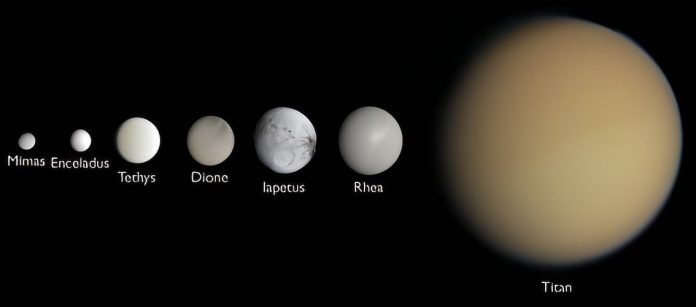
In a groundbreaking study published in the journal Icarus, an international team of astronomers have offered fresh insights into the ages of Saturn’s largest moons, throwing light on the evolution of our solar system’s outer reaches.
Led by Emily Wai Wong from the Earth-Life Science Institute (ELSI) at the Tokyo Institute of Technology, the study suggests that five of Saturn’s largest moons—Mimas, Enceladus, Tethys, Dione, and Rhea—are between 4.1 and 4.4 billion years old.
Methodology
In the absence of radiometric dating samples from Saturn’s moons, Wong and her team turned to establishing a crater chronology for these celestial bodies.
Using high-resolution simulations and estimates of trans-Neptunian object (TNO) populations, they calculated the ages of Saturn’s moons based on the number and distribution of impact craters on their surfaces.
Findings
Their findings indicate that Mimas and Enceladus, the two innermost moons, are relatively younger with estimated ages of around 4.10 and 4.16 billion years, respectively.
In contrast, the outer moons Tethys, Dione, and Rhea are older, with ages approximating 4.4 billion years. These age estimates also showed a pattern, generally increasing with increasing orbital distance, except for Mimas and Enceladus.
Implications
The study has far-reaching implications not just for our understanding of Saturn’s moons but for our broader understanding of the solar system’s history.
“The results imply that Saturn’s regular satellites are old, significantly influencing our perspective on their formation and tidal evolution,” said Wong.
The refined methodologies for determining the age of Saturn’s moons could also be applicable to the moons of Jupiter, Uranus, and possibly Neptune.
This has the potential to expand our understanding of these planets and their satellites, thus enriching our view of the solar system’s history.
Collaborative Effort
The international research team included Ramon Brasser from ELSI and the Origins Research Institute, Stephanie C. Werner from the University of Oslo, and Michelle R. Kirchoff from the Southwest Research Institute (SwRI).
The research brings us a step closer to unraveling the complex histories of Saturn and its moons, and by extension, our solar system.
“By using crater chronology, we can not only estimate the age of Saturn’s moons but also create a timeline of impacts in the outer solar system.
This timeline can serve as a window into the migration patterns of celestial bodies and the bombardment history of the outer solar system,” Wong concluded.
The research findings can be found in Icarus.
Follow us on Twitter for more articles about this topic.
Copyright © 2023 Knowridge Science Report. All rights reserved.



